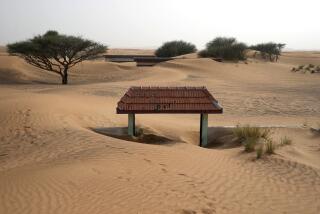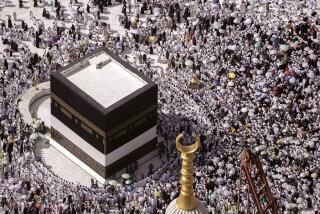Not Like ‘1,001 Nights’ : Old Baghdad: Mix of the New and the Funky
- Share via
BAGHDAD, Iraq — Along Haifa Street in central Baghdad, the older parts of Iraq’s historic capital have been carefully obscured by the new.
High-rise, gray-brown apartment buildings built by Korean companies line the boulevard, lending an antiseptic quality to the west bank of the Tigris River, which 1,000 years ago was the capital of the Abbasid empire and the center of the civilized world.
Now, there are shiny new glass bus shelters, art deco street lamps, and even the street’s name is new--a gesture of Iraqi solidarity with Palestinians who fled Haifa in 1948.
Remnants of Old Baghdad
Just visible behind the concrete high-rise towers are the remnants of old Baghdad, sagging yellow brick buildings, uniformly two stories high. The old is separated from the new by a 12-foot-high iron fence, dividing not only neighborhoods but also the poor from the affluent.
The older neighborhood has a funky, decayed look about it, with delivery boys carting Arabic bread the size of pizzas fresh from the clay ovens of a bakery that seems aged but not ancient. Along the side streets, artisans in bare feet ply their trades from tiny storefronts, offering shoes, electrical appliance repair, tailoring.
The new apartments are examples of anonymous comfort, each offering a tiny balcony large enough to unfurl a three-foot laundry line but little else. The central air conditioning has removed one of the wonderful architectural charms of Baghdad--walled roofs where families could sleep in the blazing heat of summer.
For the past nine years, Baghdad--residents use the Arabic pronunciation which makes it sound like BAR-dad with a gargle on the “r”--has been transformed from a run-down Middle East backwater into a modern, if unsightly, metropolis.
Ambitious Redevelopment
Thanks largely to huge oil surpluses in the 1970s, the Iraqis embarked on a lavish redevelopment plan for their capital, crisscrossing the city with six-lane expressways, building a new airport, and creating a skyline of hundreds of utilitarian apartment buildings to house the population, now estimated at 3.8 million people.
“It’s a Western capital now,” lamented one Baghdad intellectual. “It’s not an Oriental city anymore.”
Founded in 754 by Mansur, the second Abbasid Caliph, or Islamic King, Baghdad was the “marketplace of the world” on the trade routes from East to West. Baghdad was the setting for many of the lush fantasies of “A Thousand and One Nights,” as well as providing such amenities as the world’s first universities and hospitals.
‘A City Without Peer’
Under the rule of Harun Rashid in the 9th Century, Baghdad became, in the words of one Arab historian, “a city with no peer throughout the whole world.” The cultural and economic life made the Holy Roman Empire under Charlemagne, then flourishing in the West, seem rudimentary in comparison.
But Baghdad was devastated by the Mongol warrior Hulagu in 1258 and by civil war. Iraqis of today still quote the tradition that the Mongol attack on Baghdad made the Tigris run red one day and blue the next: first with the blood of the citizenry, then with the ink of millions of destroyed books.
The historian Philip Hitti remarked in his 1937 history of the Arabs that “of the architectural monuments which once adorned the city . . . no trace has been left.” So thorough was the destruction of the ancient city, that experts are unsure even where the ruins of old Baghdad lie buried.
World-Class Hotels
One of the motivations for the recent renovation of Baghdad was that it was chosen as the site of the 1983 Summit conference of Nonaligned States, a chance to put the city on show. Large areas of older Baghdad fell before the steam roller to make way for half a dozen world-class hotels.
The urban renewal touched off a real estate speculation boom that persists to this day. Thousands of old shanties in squalid, foul-smelling slums were cleared away, and their owners were reimbursed with huge benefits--some homeowners were said to have received $450,000 for two-room huts. The result was a huge rise in housing prices elsewhere in the city as the displaced looked to new neighborhoods.
The nonaligned conference also provided the justification for construction of the new Saddam International Airport, named after the country’s ruler, President Saddam Hussein. In the end, the onset of the Iran-Iraq War forced the summit conference’s organizers to move the meeting away from Baghdad, so the delegates never saw the “modernization” that was wrought for their benefit.
Beautiful Mosques Restored
The renewal program not only cleaned up some of Baghdad’s worst slums, but it renewed the city’s architecturally stunning mosques, many of which are hundreds of years old and have been completely redone in dazzling mosaic tile. In contrast, the city’s ancient churches--Baghdad has a Christian population estimated at 250,000--seem decrepit.
Although Iraq is an oil giant, its resources have been depleted by its war with Iran.
The oil money has long since run out, so areas of the city destined for the next stage of urban renewal will have to wait. Instead, the government has built an immense decorative wall to hide the worst of the slums from view.
Hussein has ruled Iraq since 1979, and his picture, displayed literally everywhere in the city, is virtually the only permitted civic decoration. There is Field Marshal Hussein with cavalry saber standing in Jumhuriya Square, and Hussein in Italian suit and designer sunglasses smiling up from the Ministry of Information, staring down from apartment buildings and cheerily peering out of shop windows.
Men Imitate Hussein
Hussein has become such a central figure in Iraq that the men in Baghdad appear to consciously imitate his appearance down to his bushy black mustache and close-cropped black haircut.
Since the Abbasid era has long vanished, the “older” parts of Baghdad tend to reflect British rule, which was present from the end of World War I to 1932. Rashid Street, the once-popular shopping district, is also known as “the street of columns” for its columned buildings, a sight familiar from the West Indies to India, which were one under British colonial government.
One of the few remaining truly ancient buildings in Baghdad is the Khan Murjan, an old Turkish restaurant made out of a renovated caravansary. The patrons now sit in the central area of the immense, old, domed building, where camels used to be quartered while their owners were in the rooms inside.
A heroic statue on Rashid Street now marks the place where a close friend of President Hussein, Abdul Wahab Ghureiry, was gunned down during an unsuccessful coup attempt in 1968.
Baghdad’s ‘Rodeo Drive’
Rashid Street’s place as the toniest boulevard in town has been taken over by adjoining Saadoun Street, and while Saadoun is newer, it is a far cry from Fifth Avenue or Rodeo Drive.
In the cool evenings of March, the street was thronged with pedestrians who window-shopped at stores offering Chinese underwear or a display of socks from Taiwan.
Another favorite locale for strollers is the eastern embankment of the Tigris, where so-called masgouf restaurants (grills) line the shore of the river, now nearly overflowing its banks.
The masgouf are among Baghdad’s gems, offering the enormous Tigris River fish--many are the size of sharks--grilled over an open fire made from the driftwood that is carried down the river.
Small, white-tiled pools line the sidewalks in front of the restaurants where the fish swim in neat rows waiting to be chosen by a customer.
Boisterous Night Clubs
The embankment also boasts a number of boisterous night clubs--as a socialist and highly secular regime, Baghdad is one of the few cities in the Persian Gulf region where cocktail bars are common. Walking along the river embankment, it is hard to imagine a war taking place only a few miles away as men line a bar drinking draft beer and watching sports--a soccer match from Kuwait--on large color televisions.
Another sign of the modernization of Baghdad is the traffic, which now has modern cantilever bridges to carry it back and forth across the river and freeways to speed it around town.
The traffic looks anything but Middle Eastern: red double-decker buses from Hungary, Toyotas and omnipresent Volkswagen Passats made in Brazil. The Volkswagens were part of a massive government campaign to compensate families who lost relatives in the war. Purchased in barter for Iraqi oil, the Brazilian Volkswagens are a permanent part of the Baghdad landscape.
Another peculiarity of Baghdad is that it is rare to find a car without a damaged windshield. Rocks the size of golf balls are still common on side streets, and most cars have the spider-webbed look on front and rear windows of having been struck by heavy gravel.
More to Read
Sign up for Essential California
The most important California stories and recommendations in your inbox every morning.
You may occasionally receive promotional content from the Los Angeles Times.













